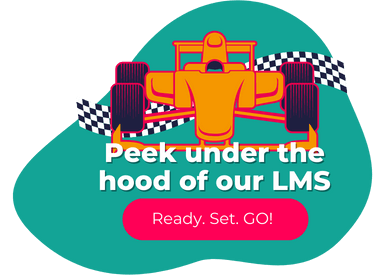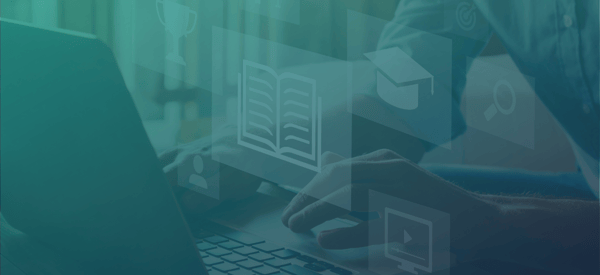Learning management systems (LMS) continue to grow in popularity. At least one report says more than 80% of organizations currently use an LMS.
From internal training in human resources to product training in services and customer success, a learning management system is versatile and valuable for your business.
Despite the popularity, many still have questions about this new world of delivering educational content. We sure did when we were building our learning management system, HubLMS.
So, let’s dive in and uncover what a learning management system is, and how it can help your business.
What is a Learning Management System?
At its most basic definition, a learning management system is a software application that provides the framework to handle all aspects of the learning process digitally. An LMS is where you house, deliver and track your training content.
Problems an LMS Solves
One way to define something is to look at what it does. Here are two business problems a learning management system solves.
Internal Training/Onboarding
A well-trained team member isn’t just nice. It’s critical.
Better training empowers employees to be more effective and efficient at their jobs. It also improves employee engagement, which increases productivity.
But training can get expensive. And with remote teams growing, in-person training has become less effective. An LMS helps you create an engaged learning environment that is managed from a central software solution.
Customer and Prospect Training
Once upon a time, ebooks, webinars and email campaigns helped marketing and sales hit their numbers. Over the years, content influx has changed your customers’ and prospects’ perception of value when it comes to content.
A learning management system helps you deliver educational courses to prospects and customers alike.
So whether you’re building a marketing machine that develops evangelists, or sales training that has prospects knocking on your virtual door, an LMS can solve the problem of lackluster premium content.
What are the Benefits to a Learning Management System?
From employee onboarding to professional development to customer education, an LMS brings your business many benefits. Here are just a few.
- Save money - Training and teaching via a learning management system reduces employee travel and printing costs, optimizes training expenditure and usage, and minimizes facilities and instructors to pay. From the cost savings aspect, an LMS is a no-brainer for most businesses.
- Create consistency - Training and course delivery via a learning management system is consistent because it is centralized. It delivers a consistent training and learning quality to all employees, no matter their location, by supplying a single source for content, course materials and instructions.
- Track learner progress and performance - An LMS allows you to easily generate training reports on an overall or user/student-level basis. When you use an LMS for eLearning courses and/or online training, trainers can easily track goal progress, knowledge gains, ROI and more.
- Meet regulatory compliance - Many industries may be required to train, assess, and report for compliance purposes. Just a few of these industries are oil and gas, pharmaceuticals, communications, and building and construction. A learning management system can help you satisfy these legal and regulatory requirements.
- Secure corporate training - You can enable a secure sign-on for your courses to keep the information and processes private only to those who need access.
- Continuous employee development - Learning doesn’t end after the first 90 days. You can use an LMS to improve employee performance with regular access to skill building and professional development.
What are Common Learning Management System Definitions?
Don’t let technical jargon stand in the way of understanding LMS. Here are a few acronyms and words you may see pop up frequently.
Student Experience
Different LMS tools offer different features for building student experiences.
- Some are tied to marketing automation to send welcome emails, reminders to complete courses learners have started, or recommended next step content.
- Some offer experience building tools connected to your learning content library and your learners’ profiles to provide a dashboard that keeps track of progress through courses, make recommendations based on quiz scores or course completions, and more.
- Some offer customizable certificates of completion.
If you are evaluating an LMS, make sure to ask for examples of what is possible for building great experiences for your learners.
SCORM
You’ll likely hear the term “SCORM” when learning about the LMS world. That’s SCORM, not SCARN, like Michael Scott’s FBI character from “The Office.”
The acronym stands for “Sharable Content Object Reference Model.”
Sharable Content Object (SCO) means creating units of online training material that can be shared across systems. SCORM defines how to create sharable content objects or SCOs that can be reused in different systems and contexts.
The Reference Model reflects the fact that SCORM isn’t actually a standard. SCORM simply references these existing standards and tells developers how to properly use them together. This means SCORM defines a specific way of constructing learning management systems and training content so that they work well with other SCORM conformant systems.
What does this mean for you? An LMS that is SCORM compatible will ensure that you can share your educational content across numerous platforms without having to recreate each unit from scratch for that particular platform. SCORM is not necessary for all those seeking an LMS, only if you have particular complex and deep learning needs for your situation.
At the time of this article, HubLMS.io is not SCORM compatible. However, our development team is working on this as a future functionality.
Tin Can API
Experience API (Tin Can API or xAPI) is an alternative to SCORM.
It’s a compliant content management system built-in for authoring content and adding elements. Tin Can API enables the recording, tracking, personalizing and improving of learning activities, both on and offline. It offers a more nuanced picture of how people engage with blended learning experiences.
You can also use it to make direct links between people’s learning experiences and their on-the-job performance.
Learning Record Store
The learning record store (LRS) allows you to store your data in one centralized location. The LMS then accesses and returns the data to the store to keep track of learners’ performance. You can, for instance, monitor a learner's achievements or the badges they’ve earned.
What Do the Best Learning Management Systems Look Like?
The best learning management system needs to work for your business by solving for what you actually need. That will look different for every company.
Here are a few things to look for in an LMS.
Does your Learning Management System:
- Provide learning experiences that are adapted to individual learners?
- Make it easy for instructors to make notes and changes?
- Give instructors and students the opportunity for online collaboration?
- Integrate common tools such as calendars, word processors, and more?
- Create a corporate culture-sensitive, branded presence for learners?
- Include insights into user progress through built-in analytics?
- Be able to scale globally as the organization grows?
What Kind of Content Does the LMS Allow?
We all learn differently. Your LMS should allow for various content like:
- Written or Text-Based Content - The basic written word. Seems simple. But your LMS should be able to host rich text written content complete with links.
- Audio Content - Can you host an audio file so the LMS feels like a podcast?
- Video Content - Video of the instructor and a walkthrough of the content on a screen is table stakes today. But it’s critical!
- Graphic or Visual Content - Can the LMS host images? Infographics? Sometimes you need to be able to show and tell.
- Downloadable Documents - From study guides to spreadsheet templates, the best LMS will allow you to utilize different documents.
- Quizzes & Polls - What learning experience is complete without a quiz or poll? A good learning management system allows you to keep your learners engaged with quizzes where you want them.
Now What?
So you’re seeing the value of a learning management system. Great!
Keep looking into the kinds of solutions you have available. Look up frequently asked questions about LMSs to find out what others ask so you’re better pre

pared. Plus, consider the bigger software picture. For instance, as your learners join your LMS world, where does that data live? Is it in one place (like HubSpot CRM)?
Finally, check out real world examples of an LMS in action, like HubLMS here.
.png)


